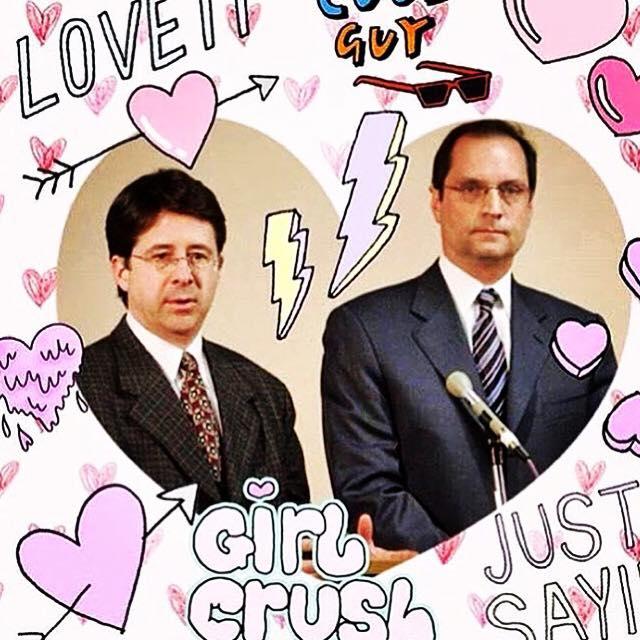
SPOILER ALERT. Murder. Image: <a href="http://mariadoesyoga.com/">Maria Does Yoga</a>
In a generation being raised on CSI, Bones, and other crime shows I don’t know about, we all want to solve the murder.
What is it that we want in our entertainment, America? Murder? Mystery? Intrigue? Suffering? Two nerdy-hot defense attorneys? Our TV viewing habits may be giving us away as the voyeurs that we are.
Every few months or so, pop culture seems to cultivate a Show To Rule Them All. Sometimes the appeal is easily recognizable; for example, Orange is the New Black, which provides us a peek inside life on the inside.
OITNB has all the important makings of a hit: a well-known and expansive offering of characters (female and imprisoned to boot), just bizarre enough subject matter to be interesting without being too fringe, love and sex (both straight and gay — vanilla and not so much), classism, racism, diverse representation of gender (including a transgender actress!), sex, religious preferences, race, ethnicity.
Sometimes, though, the appeal is a bit more nuanced. As it is with Netflix’s newest offering, Making a Murderer. Unless you live in a cave, you know Making a Murderer exists, and you probably are also aware that everyone and their mother/brother/dog watches it. I barely even watch TV and I watched the WHOLE THING. All 10 episodes. If you know me, and you know that most of my TV viewing is spent on things like Ken Burns documentaries and shows filmed underwater, you also now know this show is serious.
Let’s review: Making a Murderer chronicles the life and trial(s) of one Steven Avery. Steven is a (questionably) fine fellow who was accused of a brutal rape in the 1980s, convicted (wrongly), and sent to prison (for said conviction).
Steven proclaimed his innocence, and eventually DNA testing caught up with his claims and proved that he wasn’t, in fact, responsible for the rape. To sum up: He was convicted in 1985. He was exonerated. He was released in 2003. He was awarded several MILLION dollars (36 of them) for his pain and suffering and loss of income as the result of his imprisonment.
Steven went, almost overnight, from bearded inmate to clean-shaven poster child for police mismanagement and the failings of the American judicial system. The world got real (justifiably) mad for Steven, because 18 years in prison is a long damn time — even if you did do the thing you are in there for — made even worse by the fact that Steven was innocent.
Well as fate, or homicidal tendencies, would have it, just two years after his release, a woman, 25-year-old Teresa Halbach was brutally murdered (and raped, according to the charges). Steven was charged for Teresa’s murder and sent back to trial (along with his 16-year-old nephew Brendan Dassey as an accomplice) and then…
SPOILER ALERT:
… subsequently tried, convicted, and sent back to prison (also in prison: his nephew).
Bummer.
Steve, his family, and a whole ton of other folks (including aforementioned nerdy-hot attorneys) think Steven was framed for the murder (ostensibly by the county, because they didn’t want to pay/did not have all the millions they owed Steven). The evidence is circumstantial, and some of it is missing entirely. The cops were “bad” before, could they be bad again? It all seems a little fishy (Well, from Steven's standpoint, anyway). Teresa’s family, understandably, disagrees. And we are all just standing around shrugging.
Enter: Making a Murderer.
And now enter the question: Why?
This show went from relative unknown to absolute 5-star success almost literally overnight. My God, why? It’s not flashy: There is no colorful scenery, no Wes Anderson-like cult following, no fancy camera equipment, no large breasts or nudity, not even good film, really. And yet, every damned person I know is watching this show.
WHY? I have my theories.
We always like a good murder. It’s morbid — bordering on psychologically deviant, even(?) — how much we want to know about a good old-fashioned killing. We just can’t look away.
It’s like that time I heard that Nicki/Drake/Lil’ Wayne song “Truffle Butter” and I was like, “Sean (my 17-year-old), what is truffle butter? Is it not the exquisite oil extracted from truffles? Because that doesn’t make sense in this song.” And he was like, “OMG MOM DO NOT GOOGLE IT.”
And then I Googled it.
DO NOT GOOGLE IT.
You totally just Googled it.
See? We can’t look away.
Also, who doesn’t like a good mystery? In a generation being raised on CSI, Bones, and other crime shows I don’t know about, we all want to solve the murder. It’s the Sherlock in us all (oh there’s another one, Sherlock! Oh Sherlock, how do I love thee…uh, moving on); we just need to know whodunit. And if we can decipher the code, find the missing link, single out the bad guy, we’ve won. It’s a contest that isn’t real, and even if the murderer/thief/bad dude is completely obvious (Come on! The cabbie in Season 1: Episode 2. Come on.) it’s still some sort of late-night viewing victory. (See. I knew it was the cabbie. I KNEW IT.)
I think there is something deeper in Making a Murderer. We don’t have the whole story (probably), but that doesn’t really matter — at face value we just want Steven to be NOT GUILTY. So bad. We want to believe that this guy, falsely imprisoned for a rape he was never even near, is now falsely imprisoned for a murder he was framed for. And we want him to win. We want his nerdy-hot attorneys to clear his sullied name. We want him to go home and marry his girlfriend and just be a human.
But there's more. To get to the heart of it, you have to dig a little deep; past the rubber-necking. Past the armchair detective work. Past the whodunit and the lure of Benedict Cumberbatch.
(That Sherlock is for you.)
It’s down in there.
We want, we need, Steven — people — to be inherently good. We want to believe that when Steven Avery — or our partners, our friends, our kids — look us in the eye, they are telling the truth. If they are engaged in some form of deceit, we would know. That some twitch or flinch or micro expression might betray them. That a man who didn’t commit rape also wouldn’t commit murder. That we haven’t wasted 10 hours of our life — 10 hours we could have used to learn Mandarin or knit a scarf — hoping he’d be exonerated...only to find out he isn’t.
We want this so desperately that 275,000 of us have signed a petition to have Steven pardoned. That petition isn’t likely to gain enough force to do anything, but the passion isn’t in the petition, it’s in the people who would so steadfastly stand by a man they’ve never met, accused of a crime that is heinous and horrible and unsolved. It’s in the pause we take when we have to think about the real people in the real world who commit the real heinous acts, and we have to consider that Steven Avery might be one of them.
And we hope so desperately that he is not.







